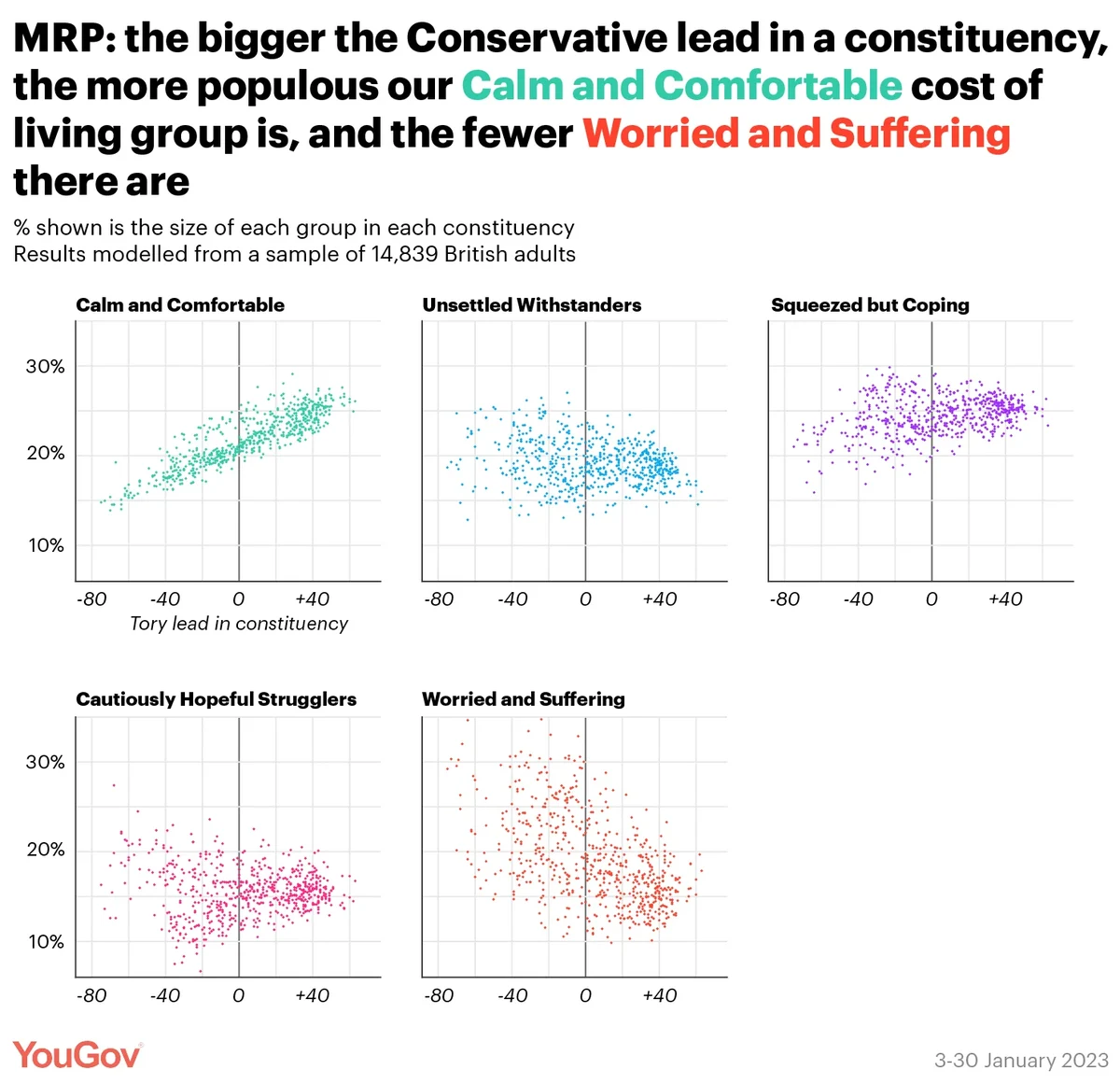Squeezed but Coping and Calm and Comfortable make up half the population in the marginal seats the Conservatives must hold at the next general election to prevent a Labour majority
Last week, YouGov published our Cost of Living segmentation research, providing new insight into how the crisis is effecting different groups of the British population nationwide.
Now, a new MRP (multilevel model and post-stratification) shines light on how our cost of living segments are distributed across the country, constituency-by-constituency. The geographical spread of our five groups has important political implications as we move toward the next general election.
The geography of the cost of living groups
According to our analysis, the Squeezed but Coping make up the largest share of the population in 396 constituencies. In 129 the most common segment is Worried and Suffering, in 89 it is the Calm and Comfortable who are most populous, while Unsettled Withstanders and Cautiously Hopeful Strugglers are the plurality segment in just 13 and five constituencies respectively.
Looking across the country, while the Squeezed but Coping are well represented in every region, they are particularly prevalent in South the South East (the largest segment in 81% of constituencies), the South West (76%), and Scotland (97%).
The Worried and Suffering are the largest group in almost half (48%) of constituencies in the North East, and over four in ten in both the North West (43%) and Yorkshire and the Humber (44%). The Calm and Comfortable are the most populous segment in 31% of constituencies in the West Midlands and 25% of seats in the East of England.
Political implications
Thinking ahead to the next general election, scheduled sometime within the next two years, how our cost of living groups vary from constituency-to-constituency could be crucial in determining the outcome – and toward which groups Labour and the Conservatives may focus their energy in order to win.
Our study focuses on four categories of constituency based on differing levels of marginality: those where the Tory majority is under 10%, those where it sits between 10% and 20%, those where it stands at 20% to 30%, and seats with a majority of over 30%.
There are clear correlations between marginality and the size of the Calm and Comfortable and Worried and Suffering groups: the stronger the Conservative majority, the more populous former prove to be and the less populous the latter.

How these two groups in particular are distributed across constituencies is very important; according to analysis of voting intention by segment released earlier this week, the Calm and Comfortable remain quite favourable toward the Conservatives, with 47% of them supporting the governing party vs 26% currently intending to vote Labour.
Meanwhile, the Worried and Suffering – those who are being hit worst by the crisis – broke in favour of Labour by 46% to 36% in 2019, and now lean even more heavily toward the party by a margin of 58% to 11% over the Conservatives.
In the seats which will be toughest for the Conservatives to defend at the next election – those with majorities of under 10% – an average of 22% of the population are Calm and Comfortable, while 18% are Worried and Suffering. This set of constituencies are where we find the highest concentrations of Worried and Suffering with incumbent Conservative MPs.
In those constituencies where the Conservatives are defending majorities of between 20 and 30%, 24% on average are Calm and Comfortable, while 16% are Worried and Suffering. This bracket contains places like Rugby, Basingstoke, and Bournemouth West – the last stands the Conservatives could make against an advancing red tide to try and stop Starmer entering Number 10 with a House of Commons majority.
In the Conservatives’ safer seats (those with majorities at 30% or above), the figures are around 25% and 16% for the Calm and Comfortable and Worried and Suffering respectively.
The proportion of Squeezed but Coping remains steady across all three categories of Conservative majorities, at 25%. There is a similarly flat line across the Unsettled Withstanders (currently more disposed toward Labour) and Cautiously Hopeful Strugglers (currently more disposed toward the Conservatives), at around 19% and 16% respectively.
Which, taken altogether, means that Labour are in a good position in terms of having a higher proportion of voters from segments leaning their way in the most marginal constituencies at the next election.
There is further good news for Labour in the fact that the most populous Squeezed but Coping group are evenly distributed across all Conservative majority categories. In 2019, this group voted equally Labour and Conservative (38% and 39% respectively) but has now turned heavily against Sunak’s party by a margin of 53% to 17%. This makes winning over the Squeezed but Coping a potentially highly electorally profitable exercise for Labour.
The Conservatives meanwhile will hope to count on having more support from an increasing presence of Calm and Comfortables the further we move up their majority line.
Labour will therefore need to target different segments to win over different types of seats. While in the most marginal contests, strategies aimed at the Worried and Suffering will be quite profitable, they will increasingly need to rely on winning over more Calm and Comfortables as they move further into Conservative majorities. At all stages, winning over the Squeezed but Coping will be vital, and any extra pickups they can make from the Conservative-leaning Cautiously Hopeful Strugglers will be most welcome.
As far as Rishi Sunak is concerned, the key to defending his party’s parliamentary majority will be to prevent Labour from peeling off as many of the Squeezed but Coping as possible, and try to restore the Conservative’s previous strength among the Calm and Comfortable – particularly in constituencies in their 20-30% majority range.
Whatever happens, Britain’s different cost of living groups will have a significant role to play in the outcome of the next general election.
Contact us to stay in touch and find out how you can use our Cost of Living Segments
Contact the Political Research team
YouGov interviewed almost 15,000 British adults between 3rd- 30th January 2023, and used a technique named Multilevel Regression and Post-Stratification (MRP) to model the estimated YouGov Cost of Living segmentation distribution at the British parliamentary constituency level. MRP models work by first estimating the relationship between a wide variety of characteristics about people and their opinions – or, in this case, segment allocation – in what is called a ‘multilevel model’, which allows us to account for specific area (in this case, parliamentary constituency) level effects as well as background information about respondents themselves. Using a Bayesian approach, the model repeats this process a number of times, simulating different potential effect sizes and relationships and storing the results of each iteration in what is known as a posterior distribution. MRP then uses data at the constituency level based on the concentration of various different types of people who live there. The model then assigns a probability of each type of person being in each of our cost of living segments, repeating the process iteratively from random draws of the main model’s posterior distribution. In this instance, 500 draws from the posterior distribution of the multilevel model were used to predict the constituency-level probabilities, which ran for 10,000 iterations across four parallel chains. MRP has been successfully used to predict the outcomes of both the 2017 and 2019 UK general elections.
Photo: Getty









